2017 Will Be the Year of The… My Predictions for the Upcoming Year in AV Technology
After years of a terrible world economy and very little innovation, 2016 was a boon for new technology — especially in the world of AV. And, some of it crossed both high-end residential as well as commercial. Let’s take a look at a little of what was 2016 and then I’ll tell you want to realistically expect from 2017 in the way of innovative technology in AV.
4K, 4K, 4K: I have to start with that one. 2016 will forever be remembered as THE YEAR 4K debuted. It was the talk of all four major trade shows including ISE, InfoComm, Integrate and CEDIA Expo. We’ve seen more 4K products (including displays, cables, switchers, scalers, decoders, transcoders, servers and media players) than any other single technical innovation of the year. 4K is going to be big business and HUGE in 2017 — keep reading to hear why.
2016 FINALLY brought us the long-promised AV/IT convergence that everyone’s been touting (including yours truly). Sure, we’ve had networked-audio for years — thanks to Audinate’s Dante system. Video seemed like it was never going to be networkable, but companies like AptoVision have led the way in AV-over-IP systems, partnering with more than 10 different companies that are already building 4K-over-IP systems or plan to in 2017. Those include ZeeVee, iMAGsystems, IDK and Gefen. In addition, biggies like Crestron and AMX have also announced 4K-over-IP systems. And, each one of those companies is offering a plethora of options — with various compressions rates — depending on what your customer wants quality- and cost-wise.
The laser projector made its debut in 2016 with companies like Sony and Barco leading the way — they shipped laser-phosphor products that not only promised to have amazing colorimetry, but actually did. Laser might well end up being the saving grace for the projector market too, as it’s currently being swallowed up by the flat-panel monitor companies.
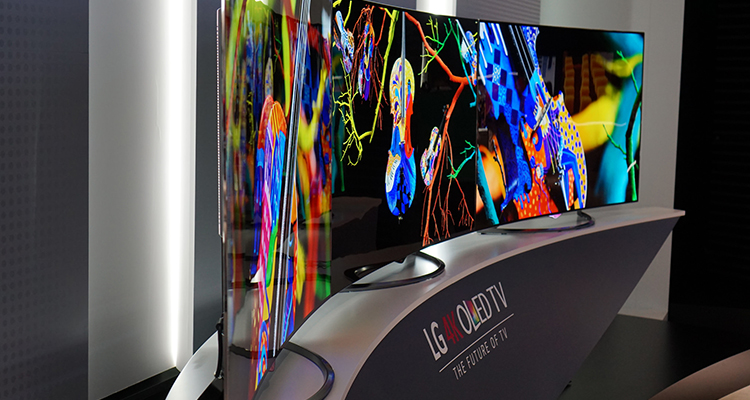 With regards to flat-panels, the big news this year had to be from LG. LG managed to launch both concave and convex displays as well as what they are claiming as wall-paper displays. All of them use the future-forward-thinking OLED technology that we’ve been hearing about for, well, a decade. At ISE, InfoComm and at Integrate, LG had one of the most popular booths as everyone wanted to see the creative applications of OLED.
With regards to flat-panels, the big news this year had to be from LG. LG managed to launch both concave and convex displays as well as what they are claiming as wall-paper displays. All of them use the future-forward-thinking OLED technology that we’ve been hearing about for, well, a decade. At ISE, InfoComm and at Integrate, LG had one of the most popular booths as everyone wanted to see the creative applications of OLED.
Speaking of large booth crowds — Sony, at InfoComm 2016, blew away all booth attendance records with the launch of its Micro-LED called Canvas. It’s expensive but the company showed a pixel-less 8Kx2K resolution image that was 35 feet wide. If you were listening at InfoComm, it’s all you could hear anyone talking about it.
Innovations in 2016 weren’t relegated to video. In fact, 2016 was a big year in audio too. Harman — the industry’s biggest audio company — was purchased by Samsung, but not before debuting the largest line of network-based audio products across six different subsidiary brands. All use Dante as the networking platform and allow for networkable everything — including speakers individually addressable via the network. Now, just about every speaker company does this. So, instead of planning the “zones” of a distributed audio system before install, you can do it any time now — and change them on the fly.
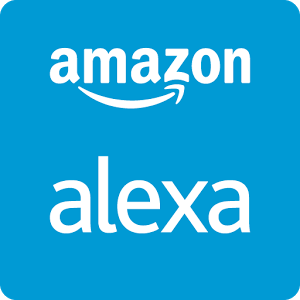 Have you heard of Amazon Alexa? Although it’s aimed at the consumer market (to encourage them to order more stuff from amazon.com), it’s being adopted by all the control system companies as an option for voice control. Amazon is happy to oblige, making its API for Alexa development open and free for anyone to use!
Have you heard of Amazon Alexa? Although it’s aimed at the consumer market (to encourage them to order more stuff from amazon.com), it’s being adopted by all the control system companies as an option for voice control. Amazon is happy to oblige, making its API for Alexa development open and free for anyone to use!
Finally, collaboration. It moved from a word meaning people working together on something to one that means the same thing as a Barco ClickShare. Yes, that happened. The ClickShare, although launched in 2012, is still dominating the wireless-collaboration market (meaning, connecting multiple laptops, tablets or phones to the same display over an ad-hoc network). Sure, there have been imitators, but Barco crossed the 150,000 unit sales mark in mid-2016. That’s a lot of boxes. Also, never underestimate an end user’s love of a simple, giant button.
So, on to 2017
If you want to see the future — I mean years-out future — go check out anything that Oblong is doing. You interact with a truly collaborative system with natural hand gestures and it’s always connected — no having to go to a meeting 15-minutes before it starts to make sure the AV technology works. It’s always on. But not everyone can afford a room that STARTS for $150,000 and moves up from there.
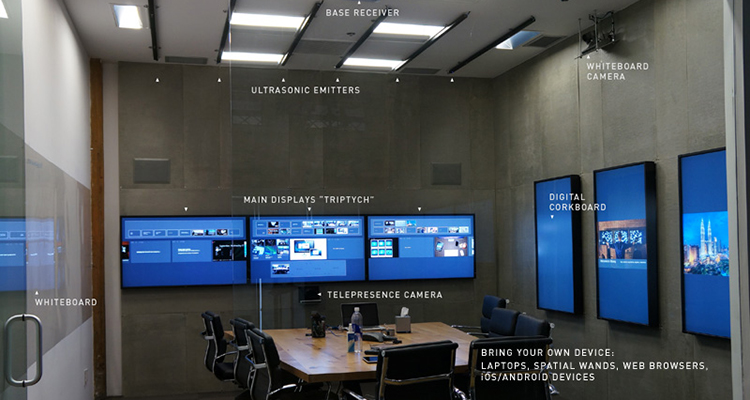
In 2017, we will see some major technological developments (some from the consumer market that will trickle-up to the commercial market) that will get nearly every room more than halfway to an Oblong Mezzanine room for way, way less. How? Well, read on!
First, let me start with the Digital Canvas. Now that we have 4K in both flat-panels and projectors, we will see the opportunity of a lifetime. And, the death of the projector can be slowed down if you offer your clients with something I call the Digital Canvas. The Digital Canvas concept is simple — and now we have projectors high-res enough to do this — instead of deciding what size screen to put in a room based on least-favored-viewer stats, you put in as big of a screen as the room can handle — fill the front of the room with projection, if you can. Then, use the projected image to provide you with your “normal-sized” projected image for PowerPoint or whatever else you’re showing but use the leftover projected image (mind you, it’s all in 4K resolution so you can actually have four PowerPoint slides up simultaneously in native resolution) to project stuff like the preview slides, a clock or even social media feeds. All simultaneously filling the front of the room — thus, you make a giant Digital Canvas.
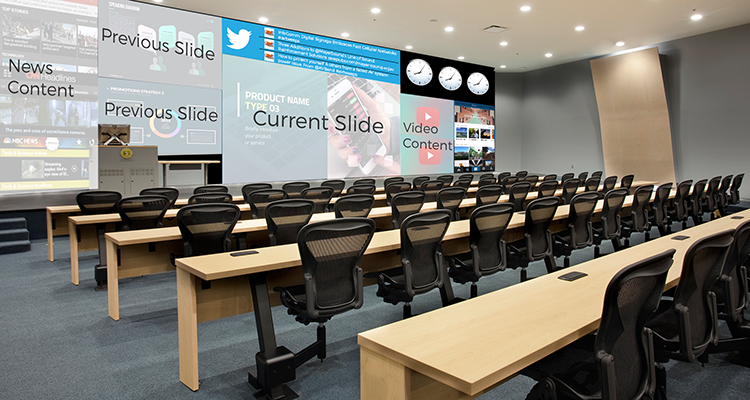 A flat-panel can’t do that.
A flat-panel can’t do that.
So, the benefit of 4K isn’t just prettier pictures — it can help us turn every room space into a Digital Canvas. By the end of 2017, this Digital Canvas concept will start to catch on as 4K projectors will be 30 to 50 percent less expensive than the first generation launched this past fall. And thanks to laser imaging, the colorimetry will be stunning. We will see blacker-blacks and whiter-whites and thus all color will look better. So, laser can be the saving grace of projection.
However, that won’t be fast enough to save the projector from being pushed almost totally out of the small to medium-sized meeting room. Nearly every integrator that specifies a screen that’s 80” or smaller now uses a flat-panel instead of a projector. That number will grow to 94” by the end of 2017 and could reach 100” depending on what Samsung, Sharp and LG decide to debut in 2017. But expect the 100” LCD to come down, considerably, in price next year.
Speaking of flat-panels, as I mentioned above, LG (and Samsung) both have curved displays which, in to digital signage, make for some creative installs. 2017 will be the year the TV/monitor moves into art in a big way. We will see more flat-panels installed for digital signage and museums than any other year before now — expect that growth to be in the 20 to 25 percent range. And, the more creative the install, the more profitable it will be. 4K will also massively drive down the price of 1080p displays, while the 4K TVs themselves will be 50 percent of what they were in cost in 2016 by the end of 2017 — making for more to install.
Virtual Reality (VR) has been in the ProAV market for years — in fact, years ago, there were companies that come to shows and built VR caves — using projection. But, now that Facebook owns Oculus, Samsung has its VR Gear and Microsoft is shipping its VR games, what is relegated to gaming now will move in to the commercial AV space. The cost of developing content for VR applications will be driven down so we, the AV market, will need to get in to the VR market for higher-end installs — virtualization in architecture, visualization of fashion, recreating history in museums and a plethora of new applications where content drives the display format. And, you will even be selling the gear, too.
Speaking of content, the way the digital signage industry works now is soon going to be the way you’re designing classrooms and meeting rooms. So, why not get into digital signage to learn it now? Here’s the deal: All the content in a digital signage system isn’t carried from display to display via HDMI or VGA. It’s all driven by the network. All the content is sent to the various displays from an integrated cloud-based network. So, playing the content doesn’t require a computer to be connected to the display (or at least the kind of computer you know computers to be). But, the content travels across the network and is output through a $200, $99 or even a $25 media player — like a purpose-built digital signage computer. So, that methodology is what will happened in the not-so-distant future of the classroom and meeting room. If the content (e.g., PowerPoint, website, slide-deck) is on the network, there will no longer be the need for a dedicated computer or VGA port or HDMI port in the room. Just keep it on the network and “play” it using the display’s media player — one that’s built-in (e.g., Samsung SmartSign) or using the $25 media player (e.g., ChromeStick). So, that, alone should be reason enough for you to get into the digital signage network (to learn how to design the classrooms and meeting rooms of the future). But in case that’s not enough — how about the fact that the digital signage market, although less than 10 years old, is larger than the entire education AV market? And, in fact, it’s the fastest growing segment of AV right now.
Collaborative systems, rather than products, will be the wave in 2017. Everyone was rushing out to build the Barco ClickShare competitor for the past three years but, everyone failed miserably. But now that the wireless collaboration market can be realized (thanks in part to bandwidth and in larger part, thanks to Barco paving the way), you will see more collaborative systems — even Barco is doing it with its new WeConnect. Sure, we will see more ClickShare competition in 2017 but, more importantly, we will see a plethora of companies debut complete integrated systems you (that are all 100 percent network-based) and you can drop in to nearly every room. Sure, not every room, but 90 percent of them, however. This will be big.
Simplicity will be a HUGE theme in 2017. This is what Amazon Alexa is all about — people turning complicated systems into something you can talk to to carry out commands — sort of like an iPhone Siri for your room. Speaking of Siri, Apple has already staked a claim to controlling the home, and everything in it, via Siri and its new HOME app. So has Google with its home line where you tell Google everything you want to do — and assuming you have Android, it works. You will see a massive more towards simplification from everyone in AV — less individual boxes and more integrated systems (or all-in-one) solutions.
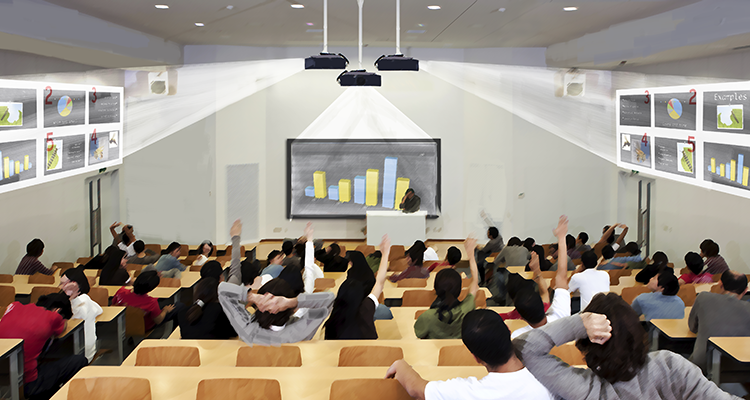 Finally, there’s one thing that I skipped that needs to be mentioned as our industry has, forever, been driven by the display. Well, I already predicted that nearly any projection system that’s under 100” would be relegated to flat-panels. And, I told you all about the applications of 4K and why it will usurp 1080p. But, in 2017 we will see the rise of tiny projectors (some pico and some just ultra-portable) cross the 3,000- and 4,000-lumen category and be cheap — like $1,000 cheap. This could change everything. And, no, it does NOT spell doom and gloom for AV. This will provide the ability to put displays EVERYWHERE. Think about it — imagine classrooms with projection on all four walls. Imagine the previous slides on the left and right walls in a lecture hall while the current slide is front-and-center. Well, you’ll be able to spec that inexpensively by the end of 2017. So, instead of putting in just one display at the front of every room, this is true multi-imaging. That’s our future!
Finally, there’s one thing that I skipped that needs to be mentioned as our industry has, forever, been driven by the display. Well, I already predicted that nearly any projection system that’s under 100” would be relegated to flat-panels. And, I told you all about the applications of 4K and why it will usurp 1080p. But, in 2017 we will see the rise of tiny projectors (some pico and some just ultra-portable) cross the 3,000- and 4,000-lumen category and be cheap — like $1,000 cheap. This could change everything. And, no, it does NOT spell doom and gloom for AV. This will provide the ability to put displays EVERYWHERE. Think about it — imagine classrooms with projection on all four walls. Imagine the previous slides on the left and right walls in a lecture hall while the current slide is front-and-center. Well, you’ll be able to spec that inexpensively by the end of 2017. So, instead of putting in just one display at the front of every room, this is true multi-imaging. That’s our future!
Oh, did I forget to mention the forthcoming 8K displays? Ugh, ran out of space in this column…





